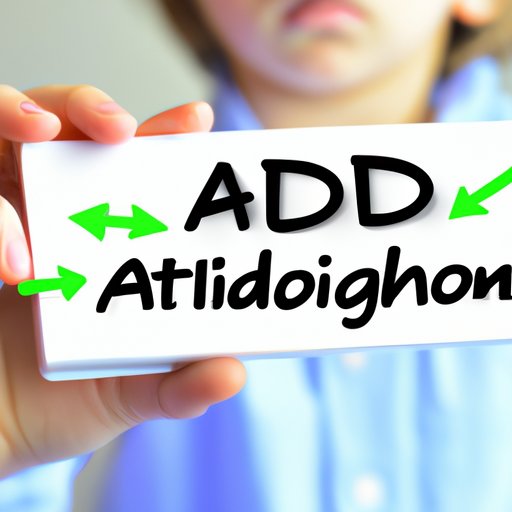Introduction
ADHD, or Attention Deficit Hyperactivity Disorder, affects millions of people worldwide and can have significant impacts on one’s daily life and relationships. The purpose of this article is to provide an in-depth exploration of how to recognize the symptoms of ADHD, the importance of seeking professional help for proper diagnosis and treatment, and practical coping strategies for managing ADHD in daily life.
Symptoms of ADHD: How to Recognize Them
The symptoms of ADHD can vary depending on the type and severity of the disorder. Common symptoms of ADHD in children may include hyperactivity, impulsivity, difficulty following directions, forgetfulness, and trouble completing tasks. In adults, symptoms may include forgetfulness, disorganization, procrastination, restlessness, and difficulty managing time.
These symptoms can have significant impacts on one’s daily life and relationships, leading to difficulties in school, work, and personal relationships. Individuals with ADHD may struggle to focus, complete tasks, and manage their emotions, leading to heightened stress and frustration in daily life.
What is ADHD? Understanding the Disorder
ADHD is a disorder that affects the frontal lobe of the brain, which is responsible for, among other things, attention, organization and planning skills. As a result, people with ADHD may have difficulties in these areas and often exhibit impulsive and hyperactive behaviours.These behaviours can be difficult for people with ADHD to control, although with proper treatment, people with ADHD can learn to manage their symptoms and lead fulfilling lives.
There are three subtypes recognized in the DSM-5: inattentive, hyperactive-impulsive, and combined type. Inattentive-type ADHD is characterized by difficulty in maintaining focus and attention, forgetfulness, disorganization and procrastination. Hyperactive-impulsive-type ADHD is characterized by restlessness, fidgeting, impulsivity and a tendency to interrupt others. The combined type is the most common and includes both inattentive and hyperactive-impulsive symptoms.
The Misdiagnosis of ADHD: Sorting Out the Confusion
ADHD is often misdiagnosed as other conditions, such as anxiety or depression. Misdiagnosis can be particularly problematic because the wrong treatment can exacerbate symptoms or cause new ones. Misdiagnosis can occur due to issues like stereotypes, poor training among health care providers, not utilizing all tests necessary for diagnosing ADHD or even because certain symptoms overlap with those of other disorders.
Factors such as age, gender, and culture may influence the likelihood of misdiagnosis. For instance, girls are more likely to go undiagnosed as symptoms may differ from those of boys and therefore may be overlooked during diagnostic evaluations. This necessitates the need for a full evaluation to confirm a diagnosis of ADHD.
The Importance of Proper Diagnosis: Seeking Professional Help for ADHD
Receiving a proper diagnosis and treatment for ADHD can make a world of difference, and early intervention can improve outcomes. Untreated ADHD can lead to difficulties in many areas of life, including academic or job performance, social relationships, and emotional well-being. A correct diagnosis is a critical first step towards finding effective treatments and strategies to manage symptoms.
The process of getting a diagnosis generally involves consulting a mental health professional. Depending on the severity of symptoms, the person affected may consult a psychiatrist, psychologist, nurse practitioner, or other specialist. In addition to assessment, the health care provider will generally conduct and a clinical interview, discuss the patient’s medical history, and may engage in cognitive testing where appropriate.
Living with ADHD: Coping Strategies and Treatment Options
There are various effective treatments and coping strategies that can improve the quality of life for people with ADHD. Medications such as stimulants and non-stimulants, Cognitive Behavioral Therapy (CBT), and Mindfulness-Based Stress Reduction (MBSR) are among the most common treatments that patients may use.
However, in addition to such treatments, there are also simple practical strategies that people with ADHD can adopt to manage their symptoms in daily life. Some of the practices that may be helpful include, for instance, breaking up complex tasks into more manageable chunks, finding an organizational system that works, clearing out excess clutter, and utilizing timers or alarms to help stay on task.
ADHD in Adults: Recognizing and Managing Symptoms in the Workplace
ADHD symptoms in adults can significantly affect work performance and career success. Disorganization, procrastination, and lack of focus can make it difficult for individuals with ADHD to work in structured environments with set deadlines. As a result, it is essential to find accommodations that can help manage ADHD symptoms on the job. Such accommodations can include alert systems that help remind one of deadlines, regular wellness breaks, and delegating or outsourcing some tasks to reduce workload and overwhelm.
Conclusion
ADHD can have significant impacts on daily life and relationships if left untreated, and it is essential to seek professional help if one suspects they may have the disorder. A proper diagnosis and treatment plan can improve outcomes and alleviate struggles in daily life. Medications, therapy, and practical coping strategies can go a long way in managing ADHD symptoms and improving the quality of life for individuals with ADHD.
